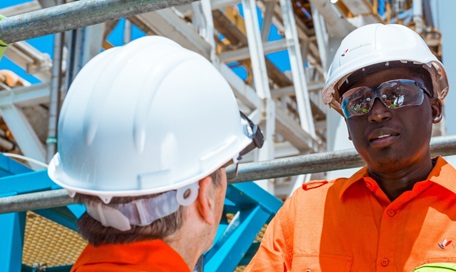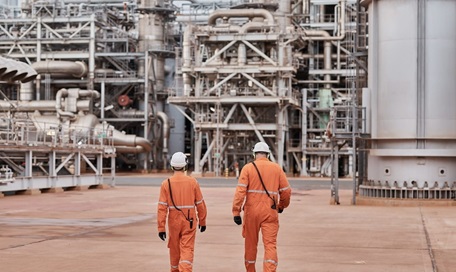Safety a priority as Goodwyn A prepares for production boost
To minimise safety risks, Woodside is exploring robotic and orbital welding for a project that will boost production from the Goodwyn A platform off Western Australia’s Pilbara coast.
.tmb-storyd.jpg?sfvrsn=97711ca2_1)
Woodside is exploring the use of robotic and orbital welding to minimise HSE risks on the Goodwyn Low Low Pressure Operation (LLPO) project. The LLPO project will boost production by installing a new compressor on the Goodwyn A (GWA) platform. It achieved final investment decision in August last year with a projected start-up in Q2 of 2027.
Goodwyn A platform is located about 135 kilometres north-west of Karratha off WA’s Pilbara coast and has produced dry gas and condensate since 1997 from the Goodwyn, Perseus and Searipple area reservoirs. It is part of the North West Shelf Project which Woodside operates on behalf of the North West Shelf Joint Venture participants.
The platform is designed for up to 30 production wells, including five re-injection wells, and has a daily production capacity of up to 36,000 tonnes of gas and 11,000 tonnes of condensate. Gas and condensate from these reservoirs are transported via a network of pipelines to Goodwyn A and then onshore to the Karratha Gas Plant for further processing.
At first, no pressure support was needed to extract gas and condensate from the wells. However, due to the natural depletion in the reservoir, in 2005 the first compression train was added under the GWA Low Pressure Operation to assist with pressure boosting. Following this success, the asset now plans to add further compression to continue to support the ongoing natural pressure decline in the reservoir.
“We need more compression power on the facility in order to transport the gas up to the onshore plant,” explains Engineering Manager Helen Bigland, who is in charge of Goodwyn’s engineering scope.
Simultaneously, a proposal has been submitted by the Project to the regulator, NOPSEMA, for proposed infill development (the GWF4 Project). This would see resources from several fields near the Goodwyn platform tied back to existing GWA subsea infrastructure. This secures Goodwyn as a key producing asset in the North West Shelf and, as such, the success of the LLPO project will be critical to its future. The LLPO project is a major scope of work that will take several years because of the ancillary works besides installing the new compressor.
"While the project is essentially about installing a compressor, there are a whole lot of changes to be made, including significant additional piping and control modifications," says Helen.
Considering the scale of this work, which looks at approximately 1.3 km of new piping, many safety factors had to be considered when deciding the method to construct these pipe lengths. The original aspiration was to eliminate all welding or “hot work” and only use flanges or Destec hubs. However, flanges and hubs carry their own risks as potential pathways for a gas leak.
Due to the extensive number of flanges in the original design and the cumulative risk that this entails, it was decided that hot work should be considered at appropriate locations. A key part of this consideration was an opportunity to utilise robotic and orbital welding to further eliminate the risk of performing hot work by significantly reducing the number of personnel and construction hours that usually accompanies traditional manual welding.
Onboard the Goodwyn A during deomilition of the existing compressor (l) and the robotic welding arm undergoing the Technology Qualification Demonstration in Norway. The arm is named Brameld after our General Manager Engineering Michael Brameld.
Graduate Mechanical Engineer Huiwen Tan has travelled with General Manager of Engineering, Mike Brameld to Norway to examine the robotic and orbital welding technology by Norwegian company, Effee.
Effee has designed the technology for the intent of welding on-site offshore pipelines. The trip demonstrated the robustness of this technology, specifically to perform the job within safe habitats and removing personnel from the hazardous environment. This enables Woodside to qualify the technology for use on its assets.
“The demonstration from Effee exemplified that we can do these activities such as welding in a safer manner than once imagined by combining the knowledge of experienced welders with new technology,” Huiwen says.
Mike Brameld first identified the potential of the Effee robotic welding technology some years ago through a long-standing knowledge-sharing agreement between Woodside and Equinor, the Norwegian state-owned energy company.
Effee visited Perth in late 2023 to present its capabilities and Vinay Lonial, Principal Mechanical Engineer Projects Australia, identified the opportunity for the GWA LLPO compressor piping scope. In response Yin Ching Chua, the GWA LLPO Project Manager, secured alignment with the Joint Venture Partners and supported funding of a formal technology qualification program.
The type of compressor being installed on Goodwyn A – a high-speed, oil-free, integrated motor compressor manufactured by MAN Energy Solutions in Switzerland.
That program, managed by Mike with support from Huiwen and DNV (an independent third-party verifier), subsequently demonstrated robotic welding could deliver code-compliant welds in a dedicated, portable and safe habitat.
“Sometimes, qualification of new technologies is the easy part; however it can sometimes be a challenge to implement them – which means it’s very pleasing to see robotic welding embraced by the GWA LLPO project,” Mike explains.
The beneficial use of this new technology on the GWA LLPO project will certainly set a precedent of how hot work is performed on offshore facilities and will demonstrate its effectiveness to enable other projects to adopt such strategies.
Woodside engineers and contractor Wood will carry out the engineering, procurement and construction work, including the front-end engineering and design. Some 18 months of construction work will be required for the construction of the compressor and piping and the asset will be shutdown in 2025 for critical tie-ins to enable this. The hook-up of the compressor will take place in the 2027 LLPO turnaround. The asset will be shut down before production is returned in stages. The ready for start-up is slated for around Q2 2027.
Helen says this significant brownfields project will prove its worth by unlocking additional gas by accelerating and increase recovery from Goodwyn GG, Perseus over Goodwyn (PoG) and Greater Western Flank (GWF).
Ragan Stonier, Vice President of Projects Australia, comments: “Our engineering team has been creative, playing a leading role in harnessing the power of innovation for our late life assets. “Achieving innovation requires extra effort on top of the day job. The outcome has also been self-generated, highlighting a truly empowered team creating value for Woodside.”



.tmb-r-story.jpg?sfvrsn=6d14cad6_1)